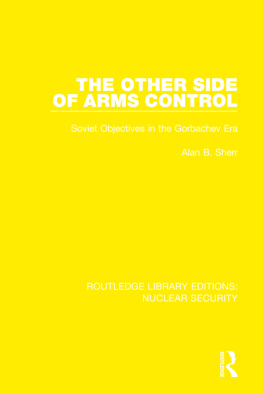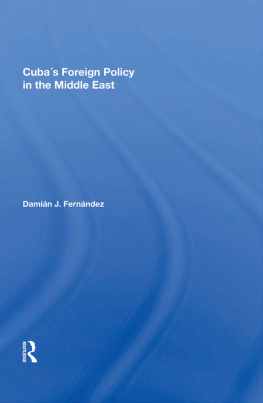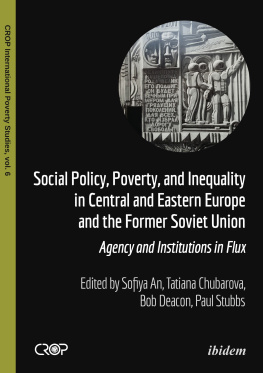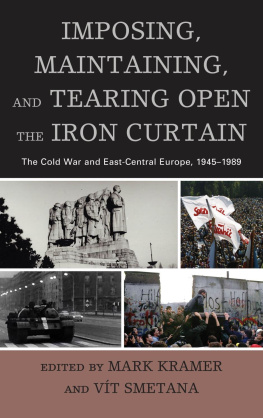U.S. Policy Toward Eastern Europe and the Soviet Union
U.S. Policy Toward Eastern Europe and the Soviet Union
Selected Essays, 1956-1988
Robert F.Byrnes

In Memory of Stephen D. Kertesz, Wise Diplomat and Scholar
First published 1989 by Westview Press, Inc.
Published 2021 by Routledge 605 Third Avenue, New York, NY 10017 2 Park Square, Milton Park, Abingdon, Oxon OX14 4RN
Routledge is an imprint of the Taylor & Francis Group, an informa business
Copyright 1989 by Taylor & Francis
All rights reserved. No part of this book may be reprinted or reproduced or utilised in any form or by any electronic, mechanical, or other means, now known or hereafter invented, including photocopying and recording, or in any information storage or retrieval system, without permission in writing from the publishers.
Notice: Product or corporate names may be trademarks or registered trademarks, and are used only for identification and explanation without intent to infringe.
Library of Congress Cataloging-in-Publication DataByrnes, Robert Francis.U.S. policy toward Eastern Europe and the Soviet Union: SelectedEssays, 1956-1988/by Robert F. Byrnes.p. cm.Includes index.ISBN 0-8133-0952-21. Europe, EasternForeign relations1945- 2. United StatesForeign relationsSoviet Union. 3. Soviet UnionForeignrelationsUnited States. 4. Soviet UnionForeign relationsEurope, Eastern. 5. Europe, EasternForeign relationsSovietUnion. 6. United StatesForeign relationsEurope, Eastern.7. Europe, EasternForeign relationsUnited States. 8. UnitedStatesForeign relations1945- 9. Soviet UnionForeignrelations1945- I. Title. II. Title: United States policy towardEastern Europe and the Soviet Union.DJK50.B97 1989327.73047dc20 89-36183CIP
ISBN13: 978-0-3672-1247-6 (hbk)
ISBN13: 978-0-3672-1528-6 (pbk)
Preface
In this volume I have collected for the first time essays of mine published between 1956 and 1988 describing and analyzing American policy toward Eastern Europe and the Soviet Union. Eastern Europe takes precedence over the Soviet Union in the books title because most Americans define Europe as Western Europe. We fail to appreciate the European character of the peoples and states of Eastern Europe, overlooking the significant role Eastern Europe has played in European history and in international politics, and especially do not recognize the critical role Eastern Europe occupies in Soviet-American relations.
The essays presented here demonstrate how Soviet actions in the last months of World War II and in the years that followed became the immediate and most important cause of tensions between the Soviet Union and the West. I believe that the relationship between the Soviet Union and the West will remain one of fear and distrust until the Soviet Union acquires confidence in itself, withdraws its forces from Eastern European states, and allows the peoples of those nations independence and the right to govern themselves.
George Kennan, who provided the intellectual framework for the policy of containment, and Walter Lippmann, who was a fervent critic of that policy from its first appearance more than forty years ago, agreed with this belief, as do most observers of European history and the Soviet-American relationship. In brief, the essays in this volume are representative of a strand of Western academic thought on one of the central issues of our time.
I have dedicated this volume to Stephen D. Kertesz, a distinguished diplomat who chose a scholarly career in the United States when his country lost its independence. His deep knowledge and good judgment concerning the political character of the Soviet-Western struggle have exercised a profound influence on many Americans.
Robert F. ByrnesIndiana University, Bloomington
Contents
- PART ONE U.S. AND SOVIET POLICY TOWARD EASTERN EUROPE
- 1 The Triumph of Containment: The Problems of Prosperity
- 2 Soviet and Chinese Communist Relations with Yugoslavia
- 3 Russia in Eastern Europe: Hegemony Without Security
- 4 United States Policy Toward Eastern Europe: Before and After Helsinki
- 5 East Central Europe: Present Situation and Principal Trends
- PART TWO THE SOVIET UNION AND THE WEST
- 6 Russian and Soviet Attitudes Toward the West
- 7 Soviet Policy Toward Western Europe Since Stalin
- 8 Exchanges of Scholars with the Soviet Union: Advantages and Dilemmas
- 9 Cultural Exchange and Competition Between Societies: An American View
- 10 Influencing Soviet Policy by Western Trade Restrictions: Some Reflections
- 11 The USSR in the 1980s and Beyond
- Conclusion: Looking Ahead
- PART ONE
U.S. AND SOVIET POLICY TOWARD EASTERN EUROPE - 1 The Triumph of Containment: The Problems of Prosperity
- 2 Soviet and Chinese Communist Relations with Yugoslavia
- 3 Russia in Eastern Europe: Hegemony Without Security
- 4 United States Policy Toward Eastern Europe: Before and After Helsinki
- 5 East Central Europe: Present Situation and Principal Trends
- PART TWO
THE SOVIET UNION AND THE WEST - 6 Russian and Soviet Attitudes Toward the West
- 7 Soviet Policy Toward Western Europe Since Stalin
- 8 Exchanges of Scholars with the Soviet Union: Advantages and Dilemmas
- 9 Cultural Exchange and Competition Between Societies: An American View
- 10 Influencing Soviet Policy by Western Trade Restrictions: Some Reflections
- 11 The USSR in the 1980s and Beyond
- Conclusion: Looking Ahead
Guide
Introduction: Looking Back
DOI: 10.4324/9780429269967-1
As lively members of an open, democratic country, schooled in a critical approach to their society and its shortcomings, Americans are particularly censorious when they consider United States policies toward the outside world. They see only problems and disasters. They conclude that American leaders and diplomats are ill-informed, incompetent defenders of American national interests. They believe that United States behavior in the international area is especially vivid proof of the correctness of one of de Tocqueville's best-known observations:
It is especially in the conduct of their foreign relations that democracies appear to me decidedly inferior to other governments.... A democracy can only with great difficulty regulate the details of an important undertaking, persevere in a fixed design, and work out its execution in spite of serious obstacles. It cannot combine its measures with secrecy or await their consequences with patience.
Georges Clemenceau, another great Frenchman, endorsed de Tocqueville, but added that the head of a democratic government allied with other states faced even greater limitations in international relations than de Tocqueville had described. The longer the First World War lasted, the more Clemenceau's admiration for Napoleon declined, as he appreciated the advantages Napoleon had enjoyed as an emperor competing with a shifting series of alliances.
In short, democracy, especially a member of an alliance system that brings together for a common purpose a number of states whose national interests inevitably diverge on occasion, faces excruciating difficulties when it confronts a state whose leader can persevere in his design without regard for his fellow citizens or the interests of associated states.











